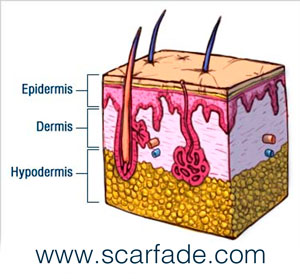 The skin is a sensory organ; the body’s largest organ. When the skin is opened, either by accident or through surgical incisions, the injury typically results in a scar. Understanding how and why scars form can make it easier to understand how they heal and how to care for your skin.
The skin is a sensory organ; the body’s largest organ. When the skin is opened, either by accident or through surgical incisions, the injury typically results in a scar. Understanding how and why scars form can make it easier to understand how they heal and how to care for your skin.
Scar Formation
When the skin is severed and wounded in the lower dermis layer, cells called fibroblasts migrate to the area and help the wound to heal by developing natural collagen. Collagen is the base for scar tissue, which builds a bridge between the two edges of the wound to fill in the area in between. The collagen bridge diminishes over time and helps the skin pull together as it forms a scar. During the formation of regular scars, which can take up to two years, the newly formed skin eventually becomes flat and slightly lighter than the rest of the surrounding area. In some cases, the body produces too much collagen, and raised or hyper-pigmented scars form.
Skin Layers
The outermost layer of the skin is the epidermis, made of three parts. It contains an outer layer of cells on the top called the stratum corneum, which are shed regularly – about every two weeks. Keratinocytes are just below this, made of cells that later mature and join the stratum corneum layer. The basal layer is the bottom part of the epidermis. The next lower skin layer is the dermis. The dermis is made of reticular fibers, elastic and collagen. The dermis also hosts hair follicles, blood vessels, nerves and sweat glands, among other things.
Differences in Scar Formation
The appearance of scars is different from person to person and from area to area on the body. The thickest layers of epidermis are typically on the soles of the feet and the palms of the hands, measuring about 1.5 mm. The thinnest are on the eyelid, usually measuring about .05 mm. The dermis also varies in thickness. The eyelid’s dermis is again the thinnest at about .3 mm. With lesser thickness to the skin, the likelihood of a cut or wound reaching the dermis is higher. When the dermis layer is injured, a scar will form.
Protective Tissue
Without scar formation, the open wounds on the body would be susceptible to attack from viruses, bacteria and further injury. Scar tissue is not identical to the surrounding areas of original skin layers. It’s tougher and shinier, because it’s made from different types of skin cells. Some scars eventually fade, although it is difficult to predict which ones will and which ones won’t. Silicone scar gel is medically proven to further the process.
